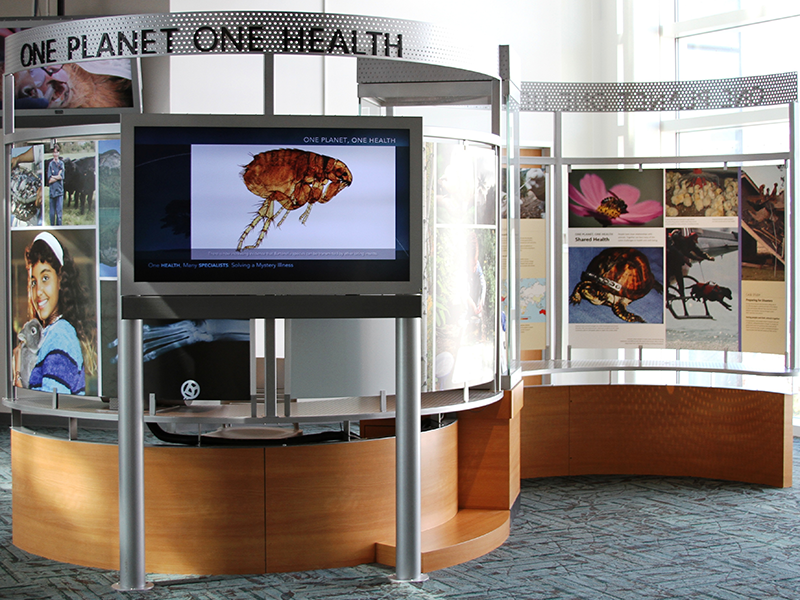The Global Health Interconnection
As the human population increases, continued research and public action are critical to understanding the balance of life on our planet, and to maintaining the health of the environment and all its inhabitants. It becomes more and more important for us to understand how the health of the Earth and the health of animals, including pets, livestock, and wildlife, relate to human health and that all are interconnected. Through a mix of text, images, video, and real artifacts the One Planet, One Health Exhibit tells many stories that help to illuminate this connection to the public.
Human health and the health of other animals on our planet are intimately linked. We all breathe the same air, drink the same water, and share the same environment. Ultimately reiterating: Healthy Environment = Healthy Wildlife = Healthy Livestock = Healthy Pets= Healthy People = One Health. It is critical that veterinarians, doctors, biologists, public health professionals, government agencies, and the public work together to keep the Earth and its inhabitants healthy. All living systems follow the same basic principles. Data collected and knowledge gained from research into these principles can be interpreted and applied to help advance health science and health management for all.
Because humans have a variety of close relationships with animals, animal health affects human health. The health of the environment directly affects the health of people and all other living things because we ultimately share and rely on the same natural resources for life. For example, keeping Earth’s water and air “healthy” is vital to the health of all.
Additional Highlighted and Illustrated Themes
- Good communication and cooperation between scientists, health professionals, government agencies, and the public are critical to maintaining the “one health” of our planet and its inhabitants.
- The lives of humans and other animals are intertwined sharing the earth and all its resources together facing many of the same challenges to health and wellbeing.
- The health of humans, pets, livestock, and wildlife are all dependent on a healthy and in-balance ecosystem. Ecosystem health, animal health, and human health are all intricately interwoven; we cannot protect one unless we protect them all. Protecting the environment is a fundamental part of human health defense. To keep our kids healthy, we must look after the whole.
- Science, research, collaboration, and public action are all critical to increasing our understanding of the balance of life on our planet and maintaining the health of people, pets, livestock, and wildlife.
Stories
- Rabies of the past and present, understanding and approach to management.
- NC taking the lead on disaster response as a holistic approach for people pets and livestock. The CDC’s Healthy Pets, Healthy People initiative.
- Local physicians and veterinarians working together to understand and cure disease. Specifically, Bartonella, a group of specialized bacteria with complicated life cycles involving multiple hosts, reservoir host, etc…can cause important vector borne diseases of humans and other animals.
- Wildlife as human/environmental health sentinels- developing surveillance initiatives involving wildlife in the field and in zoos—to monitor for environmental health challenges (contaminants/ pollution of coastal waters) and zoonotic diseases (like avian influenza). Marine Mammals as environmental sentinels – Dolphins live a long time, eat a lot of the same seafood we do, and live in water off our developing coastlines. Monitoring dolphins’ health can give us some early warnings of harmful algal blooms and toxins in the ocean.
- Even invertebrates- Honey Bees are small, familiar creatures but are an easily overlooked player in the human / animal interface. Challenges to the health of bees (specifically colony collapse) can have dramatic effects upon the availability of food on our tables. A small insect can translate into billions of dollars and its health can be directly measured by the food on the kitchen table.
- Amphibians may represent a “Canary in the Coalmine” as changes to the health of an environment may first appear in sensitive wildlife species like amphibians. Using the “One Health” approach, humans can work together across disciplines to understand and learn. Mysterious declines and mass extinctions have been reported in amphibian populations around the world. Studies suggest that currently more than 30 percent of amphibian species are threatened with extinction and more than 40 percent face a steep decline in numbers. Up to 122 species are thought to have become extinct within the last 25 years. The mysterious declines of amphibians around the world may be connected to global environmental changes like increasing ozone radiation and water pollution.
- Redtides are algal blooms that affect an entire marine ecosystem. These can lead to a cascade of threats to the health of fish, birds, marine mammals – all animals within the affected area - and humans. The actual toxins generally implicated are brevetoxins and demoic acids produced by dynoflagelates. North Carolina is a leader in research on red tides. Red tides are cyclical and have been reported for hundreds of years. There is evidence that recent cycles are more frequent in occurrence, duration, and severity.
- What One Health means to me… from informed public or experts.
Staff
- Chief Veterinarian:Dr. Dan Dombrowski | dan.dombrowski@naturalsciences.org
- Coordinator of Veterinary Sciences:Shane Christian | larry.christian@naturalsciences.org


